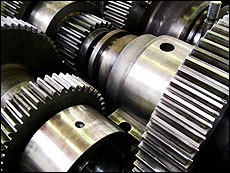The manufacturing sector has been lacklustre of late, as part of the general slowing in growth and the Reserve Bank of India's tight monetary stance. The government is eyeing an increase in the share of manufacturing in the country's gross domestic product (GDP) to 25 per cent from the current 15-16 per cent and generating 100 million jobs within a decade through its recently announced National Manufacturing Policy (NMP).
The government is eyeing an increase in the share of manufacturing in the country's gross domestic product (GDP) to 25 per cent from the current 15-16 per cent and generating 100 million jobs within a decade through its recently announced National Manufacturing Policy (NMP).
However, the share of manufacturing has not even held on to 15-16 per cent in the past six quarters, coinciding with RBI's tight monetary moves. The share has been around 14 per cent in the past six quarters.
"The biggest issue is that when the government speaks, it should not be seen as a voice with differences within its fold. Where NMP talks of tax incentives and sops, the finance minister has said giving sops would be difficult," Anis Chakravarty, director, Deloitte, Haskins and Sells, told Business Standard.
He noted that National Investment and Manufacturing Zones had been mentioned in the NMP note, "but there has been no discussion on that front till December".
Also NMP talked of adding 100 million jobs by 2022, but economists question this optimism.
"We will require 15-20 per cent growth in manufacturing every year, to add 100 million jobs in the sector," they note. The sector grew just 2.7 per cent in the second quarter of 2011-12 in value terms.
Unfortunately, the future looks gloomier. The index of eight core industries grew by an insignificant 0.1 per cent in October and the Index of Industrial Production (IIP) grew by just 1.9
Aided by the mining sector, manufacturing, which has 75 per cent weight in the IIP, is expected to drag down the numbers in October as well. With coal output contracting for the past three months, nothing better can be expected in the coming months.
Also, a slowing economy and high borrowing costs are deterring private companies from expanding manufacturing output. "The sector has been plagued by high input cost. Small and medium enterprises are also suffering from high raw material costs, stalling their growth," said Chakravarty.
In fact, GDP growth in the July-September quarter was largely due to the services sector. While services contributed 66.9 per cent to the GDP, its growth contributed 88 per cent to India's economic growth of 6.9 per cent in the second quarter.
The share of manufacturing in GDP is much higher in other Asian countries. In China, manufacturing contributes nearly 40 per cent and in Thailand, nearly 34 per cent.
According to a discussion paper on the NMP, the increasing gap in the sectoral share and the productivity of the manufacturing sector, between India and these economies, indicates we have not been able to fully leverage the opportunities provided by the dynamics of globalisation.
This has attendant socio-economic manifestations in terms of over-dependence of a large section on agriculture for its livelihood, disguised unemployment and urban unemployment.
"The journey from under-developed to developed moves from an agriculture-based economy to industry and then services. In India, we missed manufacturing and moved directly to services from agriculture," said Chakravarty.









